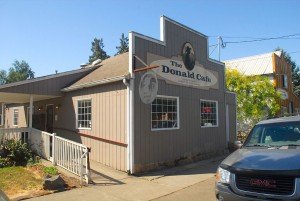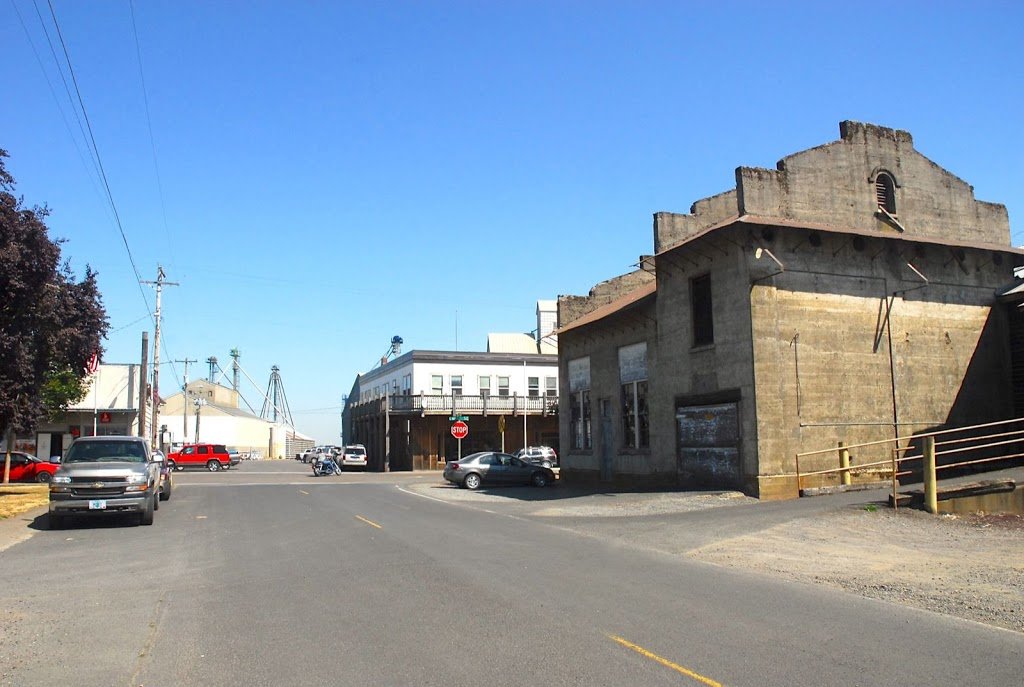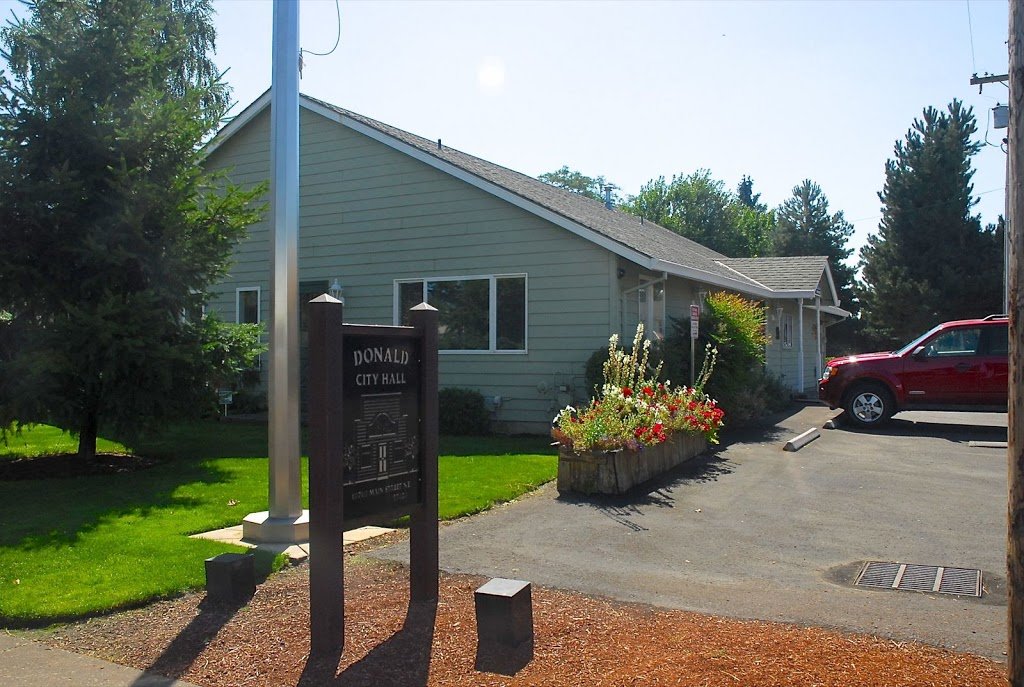Donald’s historical prosperity was fueled by success in marketing the area’s natural resources. Between 1848 and 1853, Donald’s first settlers were farmers and loggers from the Midwest. By the turn of the century, produce and lumber were transported out of the Donald area by steamboats on the Willamette with the closest stop at Champoeg. In 1907 better future transportation became possible when the Oregon Electric Railway began construction with a line between Portland and Salem. A converter sub-station was built in 1910 and was named for R. L. Donald of Portland, an official of the construction company that built the railway. The first two buildings constructed were directly related to the railway: a depot for passengers and a concrete structure to house the generators.
The nearby farming community grew with a store where the tavern is now (see structure at right in photo above) and a livery stable in the rear. The Masonic Building contained a bank and a store. A lumberyard was in the rear of this property. The Butteville Insurance Company was located to the east of the bank. By 1914, the Union meat Company had a stockyard on the north side of Oak Street. A large builders hardware store was built on East Main with a dance hall on the second floor. A saloon, shoe repair shop and barbershop soon followed. The barber shop, moved across the street, later became the Donald Cafe. The Methodist and Nazarene churches answered the spiritual and social need of the community. A school was built in 1911, and then rebuilt in 1938 after being demolished by fire.
The city was incorporated in 1912 and its most prosperous years were those of the 1920s when the Oregon Electric Railway was flourishing. During the Depression of the 1930s, trade and transportation suffered and the railway ceased passenger service in 1935. Automobiles and trucks replaced railroad service, but the main north-south highway, I-5, built in the 1950s is only a mile and a half-mile to the west, but the ramp leading to Donald makes the connection several miles longer. The city’s main transportation connection for its agricultural products has reverted to rural roads for connections to larger cities in the area.
During a visit on a sunny September midday, we strolled along the main street, beginning at the neatly landscaped City Hall and adjoining park with playground. Across the street is the Post Office (established April 13, 1910), next to a 1908 bungalow that must have an interesting story of its own. We pass a few small businesses and the Cafe, with tavern opposite. After what appears to be the main, downtown intersection, we can see the tall grain elevators to the left among the many industrial enterprises that support the city budget. The deserted Oregon Electric Railway Station Building ~ corner of William and Main Street~ represents the passenger trains of the past; the spurs lines for freight indicate the new businesses. Beyond the rail tracks, the skateboard park (described below by a resident) shares space with a basketball court on one side of the street, homes behind shaded lawns on the other. Newer residences spread out on a few streets around the downtown area.
 |
| A gathering place for residents and visitors |
Visitors interested in local history will enjoy seeing the Cone House: three blocks west of the cafe, then south on Butteville Road to Cone Street. This private residence is on your right. Built in the 1850s, it was the former home of G. A. Cone (1826-1898
Donald Skatepark is a popular local recreation spot. When it was built in 2000, Tom McWhirt remarked: “With a population of just over 600 people it seems like an unlikely place for a skatepark, yet it has captured the imagination of skaters across the nation. It’s not large, only 2,500 square feet. Two people can skate at the same time, one in the bowl and another in the flow section. What makes Donald’s skatepark so remarkable is that it exists at all. There’s a belief among advocates that skateparks are easier in small towns. The layers of bureaucracy and fears are stripped away. In a small town the skatepark is for the kids that everyone knows. They see them every day in the parking lots and sidewalks around town. These aren’t hardened skate rats who destroy quality of life wherever they go. No, they’re just the ordinary kids who aren’t interested in playing team sports. They have their own thing and that’s fine. It will come as no surprise that the skatepark sits in the middle of town. It’s such a small village that there’s nowhere else to put it.”
We have been to Donald three times since this project began, learning more and meeting more residents each time. The trick is to combine the stroll along Main Street and lunch at Donald Cafe with a few hours in St. Paul and Champoeg, less than a dozen miles to the west, or Aurora 5 miles east. You can locate all four of these historic locations, about 25 miles north of Salem, by signs along I-5 or 219. All are well worth a day’s tour for their important Oregon heritage.
For an overnight stay in a historic residence, there is the 1930s Feller House Bed and Breakfast nearby on the Butteville Road (503 678 0268), less than a mile from Donald. The land was originally part of the William Whitney Donation Land Claim. By 1874, his son-in-law, Francis Feller owned the claim. It remained in the family until 1989.
Printed tour guides of the French Prairie area are available at St. Paul’s City Hall and at museums at Champoeg or Aurora. But don’t miss Donald ~ the centerpiece of North Marion County’s heritage adventuring!
Each Tuesday, after a city was featured in that Sunday’s Statesman Journal, KMUZ broadcasted “Marion County 20”. To learn more about Donald, listen to the podcast listed on the KMUZ archives.



One Comment